

Transformation into another self has been a long standing tradition in western horror as we saw in Vee’s investigation into transformation horror in the Monster Flicks and Vampire Chicks season. The transformation into other and a loss of body control has long stood as an analogy in film but with this season I hope to investigate an alternate form of Body horror that I term “identity horror”.
Cronenberg has a long filmic history that examines body horror, the body invasion in his early works such as Shivers, his transformation or becoming horror in the Fly and Videodrome and his becoming machine in Crash. There is a section of his work that although relates to his body horror still sits slightly outside the mold. Instead of a pure becoming (although these films too contain a transformation of self which I will highlight as well) these films contain an idea of the ever present threat. Cronenbergs Double or Other in is not separated form the original self in his films Naked Lunch, Dead Ringers and A History of Violence it is another menace another self that is contained and in this sense is not Other it is within or 1 step separated from the self weather it be forgotten, embedded (and therefore) emergent or the doubled self.
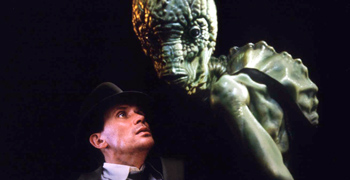
Films about writers and the creative process are not generally action-packed, but this unusual piece has plenty of incidents. The action takes place largely inside the mind of "William Lee" (William S. Burroughs) whose first book "Junkie: Confessions of an Unredeemed Drug Addict" dealt with his struggle against heroin addiction. "The Naked Lunch", is a film that melds together, almost in Burrough’s trade mark “cut-up” style, “Junkie” “Naked Lunch” the book, and scenes from a plethora of other Burroughs books including “The Ticket That Exploded”. This film can be seen as everything Burroughs and has been not as Naked Lunch but as “A film about writing Naked Lunch”.
(in short: Cronenberg's Naked Lunch is an amalgamation of Cronenberg's interpretation and experience of reading Burroughs, Burroughs own life, and Burrough's legendary novel, Naked Lunch.)
After "drying out" he has a job as a pest exterminator, killing cockroaches with powder from a cannister. He discovers that his wife Joan, still an addict, is shooting up with the bug powder and having sex openly with two of his literary friends, Hank and Martin. He then manages to kill her accidentally with his pistol ("I guess it's about time for our William Tell routine"). He flees the country and washes up in "Interzone" (Tangier - then an "international" city).

There are six or more plots operating in six or more interacting layers throughout the film, and the action centres exclusively on Burrough's alter-ego, Bill Lee, as he attempts to discover the relationships between all of these plots.
In this pure film of doubling every character has an alter ego or on screen double. Bill is doubled through bill the exterminator and bill the agent/writer, his wife Joan is doubled through her dual characters as Joan: Bill’s wife and Joan: from inter-zone, many actors play 2 characters (or one character and the voice of another).
Naked Lunch seems to be just totally incomprehensible upon first viewing. However, after watching it again, you start to understand more and more. Upon multiple viewings, you really get a feel for what's transpiring before your eyes.

“If any three of the following conditions apply see Naked Lunch:
YOU
1. ...know what the term "visual metaphor" means.
2. ...are a Burroughs, Kerouac or Ginsburg fan.
2a. ...are not a fan, but know and respect Burroughs, Kerouac or Ginsburg
3. ...can't see how the book Naked Lunch could make a good film.
4. ... believe that Peter Weller is an underrated actor.
5. ...thought any of the following films were 'lightweight': Lost Highway, Mulholland Drive, Twin Peaks: Fire Walk With Me, The Last Wave, Heavenly Creatures, Dead Ringers.
6. ...have lived in the New York area for 15 or more years.
7. ...know the relationship between improvisational jazz, poetry, and modern art.
8. ...think you understand what Andy Warhol was trying to do.
9. ... are curious about what the process of writing a novel is like.
10. ...spend a lot of time arguing with inanimate objects.
11. ...without knowing the content of this film, can see a potential relationship between sexual ambivalence, guilt, paranoia, addiction, typewriters and over-sized talking insects.
(…you should watch this movie)
You should NOT see this film if any of the following apply:
YOU
1. ...consider homosexual love to be evil, wrong, and something you can not sympathize with or understand.
2. ...use the phrase "he's on drugs" to explain behavior and ideas that do not make sense to you.
3. ...do not like or respect Burroughs, Kerouac or Ginsburg, and you know who they are.
4. have a concept of challenging literature as the latest John Irving novel (no offense to Mr Irving intended - he's easily as great as Burroughs, just sort of mainstream and pop).
5. ..like films which you can walk away from easily.
6. ...don't want to see any film which requires a second viewing to feel as if you've really got any of it.
7. ...view films strictly as a form of entertainment.
8. ...without knowing the content of this film, you can not imagine a potential relationship between sexual ambivalence, guilt, paranoia, addiction, typewriters and over-sized talking insects.
9. ...don't care to understand most of the following review.
10. ...consider ambiguity and loose ends in a film to be "plot holes" and consider any film which has them to be 'flawed'.”
Author: mstomaso IMDB


Cronenberg’s unique drama draws him to unsteady and un-plotted territory. In this portrayal of Gynaecologist twin brothers (the Mantel Brothers) and their attempt at separation Cronenberg addresses the duality of human existence. As the 2 brothers fall into a love triangle with actress Claire Niveau the brothers separate. One falls in love with the junky actress and one gets drawn into work commitments.
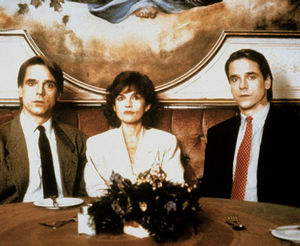
As the brothers separate they get closer to their lives falling apart. A sliding slope into drug abuse and insanity sets in and the brother’s lives spiral out of control. Cronenberg tries to engage with the idea of what twin-ness is and what it is to be twinned.
Throughout film history the emblem of the twin have cropped up as a metaphor, but has never been tackled head on, in films such as the original Dead Ringer (1964), Twins, and The Parent Trap, their twin-ess has always been sidelined and never truly investigated as solid subject matter.
The twins in this film - Elliot and Beverly - sit as an analogy for the 2 sides of the brain; Elliot the male predator and lustful deviant and Beverly as the coy, reserved and hardworking alter-ego.
In the tagline “2 bodies, 2 minds, 1 soul” Cronenberg depicts the brothers as “Siamese Twins of the soul”, 2 separate physical people joined, not physically but linked with a powerful bond. The twins are depicted as a fantasy creature, something of myth and as they wander around their fish tank apartment and create crustacean like surgical instruments, linked with the opening lines from the Mantel Brothers as small boys (along with the fact Mantel is the name given to a crabs shell) the brothers become aquatic as an analogy to their otherness, a life and existence that we can only imagine. This Otherness is flipped (or mirrored) when Beverly creates his “Instruments for operating on mutant women”. As he slips into madness he makes everyone else the genetic anomaly.
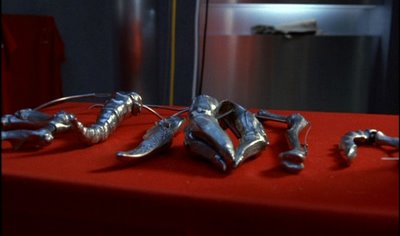
In this “doubling” of the ego by Cronenberg it throws up a lot of problems to do with the idealness of self, Beverly has what is characteristically and I would argue characterised as the female persona of the twins. In the scene where Claire questions him about his “female” name he becomes defensive and argues that is spelt differently, he tries to emulate his brother’s sexually aggressive behaviour and thus shies away from his feminised persona, ashamed of his feminine qualities and seeing them as a hindrance rather than an attribute and creating in his mind the ideal male in his brother.
This portrayal, coupled with the research that came out of Minneapolis around the same time, showing that Twins that are separated before they are aware of their siblings (thus not knowing that they are a twin) will grow up smoking the same cigarettes, living on streets and marrying partners with the same name gives the film a feeling of Biological Determinism. The brothers had no choice but to try and separate and in doing so they had no choice but to self destruct…



A History of Violence is another Cronenberg adaptation, this time from a graphic novel, opening up a cherry pie, backwater America. The title reading more like a case workers notes than a documentation of violent progression in society, this film cracks open America’s pie crust and reveals a dark past.
Often reviewed as the most un-Cronenberg film he has made to date, Cronenberg’s latest offering is a tale of emergent past. An every-mans story exaggerated and emphasised. The lurking violence of the past, an ever present history, and a hidden identity. Cronenberg deals again with a sense of duality, as with Naked Lunch, and Dead Ringers, A History of Violence holds a volatile presence, ready for the balance to tip, or the surface to be scratched, this time an ever present horror that emerges from a hidden past.
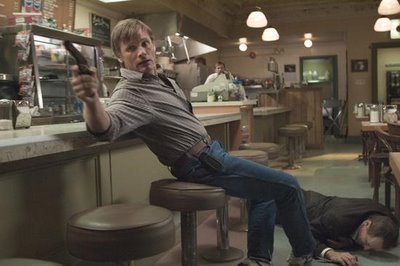
Cronenberg’s most subtle horror, in terms of viscerality, works within a typical Gangster/Revenge plot working with the “Wrong Man Scenario”. Characters echo those seen in film-noir and the old “black hat - white hat” cowboy flicks.
With the mutants stripped away and one of the most stereotypical Cronenberg dream sequences cut from the final film, this is a skin and bones Cronenberg tale of a delicacy that is lacking in some of his former works.
A character with a dual identity, one hidden (Joey) and one composed (Tom); the protagonist is a calm picket fence American living in a small town that would not be out of place in one of Lynch’s cinematic offerings. The violence in this film, the portrayal of small everyday America and the lead gangster Fogarty are all reminiscent of Lynch’s Blue Velvet.
Tom owns a diner, has a wife and 2 kids, and is a pillar of his community who is elevated to hero status by thwarting a robbery in his diner.

***THE EMERGENCE OF JOEY (this bit’s full of “spoilers”)***
The first emergence of Toms Other (Joey) doesn’t happen in the diner, the place where it is first recognised and brought to light in the “mistaken identity” sequence of the movie by the Philadelphia Gangsters, but when Tom’s son Jack has retaliated against his school bully in an unrelenting violence that springs as if from nowhere, (possibly relating to the surprise and equally violent response from Tom in the diner robbery earlier in the film). Tom strikes his son Jack for his insolence and this is the first un-masking of Joey. In this strike the surface paint that is Tom is scratched and Joey’s colours can be seen underneath by his son. Although it seems that Joey has emerged from within Tom in the diner robbery, Tom is still a submissive character and his wife still plays in the dominant role, shown by her confrontations with the gangsters both in the diner and in the shopping centre compared to Tom’s submissive diffusions of conflict.
Tom’s passivity is not destroyed by the rising of Joey until his confrontation in the garden when his son and wife are secretly watching his violence; Tom has for the first time responded to the name Joey and his son looks at him as a stranger, the emergence of Joey is complete.
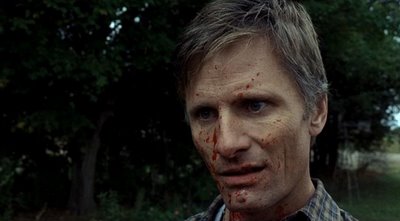
The division of the character is emphasised as the plot thickens, the otherness is released from Tom by his intruding past, and it starts a chain reaction that reveals his hidden persona. With the first questioning of Tom by the gangster Fogarty (when they first come to town), Tom’s expression is blank and takes the blunt questioning in his stride as the small town presence in the diner keeps his balance towards Tom, the identity of Tom is kept stable by his surroundings, Toms identity and its construction is inextricably tied to place. The small town reinforces his boundary, as at this point in the film, with his wife and yokel friends by his side he is Tom.
Sam the detective asks Tom if he is in witness protection and Tom replies with disbelief, as again he is with his family that shields him from his past but when Fogarty confronts Tom saying “you almost believe your own crap, you try so hard to be this other guy, its painful to watch”. Joey starts to surface, Tom’s facial expression changes, he sends his wife indoors so Joey can emerge, when his wife and son have left the Jackal to Hyde transformation is complete.
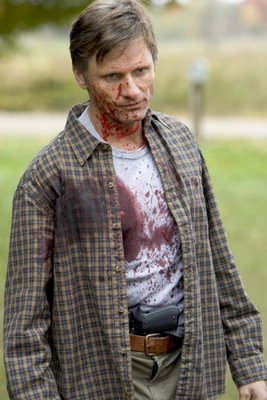
In the sexual act to follow this scene the violence is depicted as masculine virility, the sex is raw and violent and is a stark contrast to the passion seen earlier in the film. Tom is half Joey and hesitates for a second in disbelief at the emergence of his second character to his wife. In this hesitation his wife grabs Joey, leaving Tom behind. In this violent sex scene Joey and his wife’s animalistic violence are released. After the thralls of violent passion and Joey’s violence is accepted and embraced by his wife, Joey reverts to the submissive Tom. After the sex is over and the wife leaves in disgust, Joey leaves too, and Tom is left whimpering at her feet.
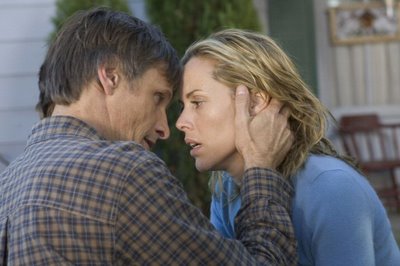
Tom refers (while laying in the hospital) to a 3 year period where he lives in the desert and kills Joey, where Joey dies and Tom is born, a rebirth. Tom’s otherness – (Joey) his violent other is referred to as dead by Tom, unlike Dead Ringers where Beverley’s other (Elliot) dies in the end sequence Joey is masked under the surface of Tom. As the film progresses and Joey overpowers Tom, (which only truly happens when Tom/Joey reaches Philadelphia) his character changes, his voice changes and he has transformed back into Joey.
Tom’s description of killing Joey is paralleled in one of the final sequences of the film when Joey washes himself in the Lake, a baron flat plane. Alone, Joey kneels by the lake side and baptises himself with water, topless and wearing a standard small town America issue silver crucifix, Tom washes away Joey and in the final sequence of the film can be reunited with his Family as Tom. He re-enters the house and is offered a place at the table by his Daughter, his son offers to break bread with him (because it is every-small-town-America the bread is replaced with Meatloaf).
The constant emergence and disappearance of the dual character in this film comes to an end in an almost iconic Christian metaphor, that although sits outside Cronenberg’s usual reference material draws a conclusion to the film where Joey has been washed away and Tom remains with his family.

Season presented by Alan Hook.
Labels: Alan Hook, Canadian Cinema, David Cronenberg, Transformation



<< Home